- Publisher's Note
- Editorial
- Guerrilla Girls: The Masked Culture Jammers of the Art World
- Creating for Change: Creative Transformations in Willie Bester’s Art
- Radioactivists -The Mass Protest Through the Lens
- Broot Force
- Reza Aramesh: Action X, Denouncing!
- Revisiting Art Against Terrorism
- Outlining the Language of Dissent
- In the Summer of 1947
- Mapping the Conscience...
- 40s and Now: The Legacy of Protest in the Art of Bengal
- Two Poems
- The 'Best' Beast
- May 1968
- Transgressive Art as a Form of Protest
- Protest Art in China
- Provoke and Provoked: Ai Weiwei
- Personalities and Protest Art
- Occupy, Decolonize, Liberate, Unoccupy: Day 187
- Art Cries Out: The Website and Implications of Protest Art Across the World
- Reflections in the Magic Mirror: Andy Warhol and the American Dream
- Helmut Herzfeld: Photomontage Speaking the Language of Protests!
- When Protest Erupts into Imagery
- Ramkinkar Baij: An Indian Modernist from Bengal Revisited
- Searching and Finding Newer Frontiers
- Violence-Double Spread: From Private to the Public to the 'Life Systems'
- The Virasat-e-Khalsa: An Experiential Space
- Emile Gallé and Art Nouveau Glass
- Lekha Poddar: The Lady of the Arts
- CrossOver: Indo-Bangladesh Artists' Residency & Exhibition
- Interpreting Tagore
- Fu Baoshi Retrospective at The Metropolitan Museum of Art
- Random Strokes
- Sense and Sensibility
- Dragons Versus Snow Leopards
- What Happened and What's Forthcoming
- Art Events Kolkata, February – March 2012
- Mumbai Art Sighting
- Art Bengaluru
- Delhi Dias
- Musings from Chennai
- Preview, March, 2012 – April, 2012
- In the News, March 2012
- Cover
ART news & views
Helmut Herzfeld: Photomontage Speaking the Language of Protests!
Issue No: 27 Month: 4 Year: 2012
by Anurima Das
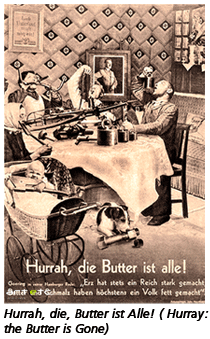 The year was 1935 when a revolutionary photomontage adorned the front page of the AIZ (Arbeiter-Illustrierte-Zeitung). The work was titled Hurrah, die Butter ist Alle! (English: Hurray, the butter is gone!) and depicted a family sitting around a kitchen table, while a portrait of Hitler hung in the backdrop and the wallpaper was inscribed with innumerable swastikas. The family included the mother, father, grandparents, a baby, and a dog who were attempting to eat pieces of metal chains, bicycle handlebars, rifles etc. The photomontage effect in question was the work of the great photomontage artist Helmut Herzfeld, who later came to be known as John Heartfield.
The year was 1935 when a revolutionary photomontage adorned the front page of the AIZ (Arbeiter-Illustrierte-Zeitung). The work was titled Hurrah, die Butter ist Alle! (English: Hurray, the butter is gone!) and depicted a family sitting around a kitchen table, while a portrait of Hitler hung in the backdrop and the wallpaper was inscribed with innumerable swastikas. The family included the mother, father, grandparents, a baby, and a dog who were attempting to eat pieces of metal chains, bicycle handlebars, rifles etc. The photomontage effect in question was the work of the great photomontage artist Helmut Herzfeld, who later came to be known as John Heartfield.
Helmut Herzfeld was born on 19th June, 1891 in Berlin and it was in the year 1916 that he finally decided to call himself John Heartfield. The idea to rename himself was his way of criticizing the Nationalism and the anti-British sentiment prevalent in Germany during that period. It was the nationalistic slogans and the temperament towards England that angered and disturbed the artist and he finally worked in his way to bring out his protests and declare his anti- Nazi sensibilities. In 1918 Heartfield joined the Berlin Dada group and the German Communist Party in protest of the barbaric practices prevailing in Germany at that point of time. This was one of the most pivotal points of his life as, his photomontages and vehement protests started shaping up after this in a more profound way. Though, it took him a few years to shape up his protests and achieve the glory of being known as the 'father of photomontage' but he had already begun walking the path long back. It was back in 1914 that in the midst of the chaos of the World War I Heartfield joined the German military but, it took him just a year to realize the adulteries. He finally resigned of his services and along with his brother begun working to revive an old German monthly magazine with their newly founded publishing company, Neue Jugend, or New Youth.
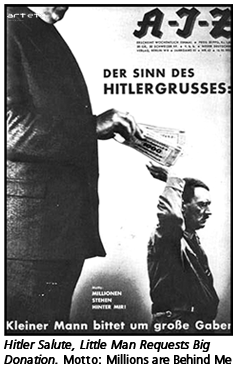
 Participation in the Berlin Dada group helped the artist churn out his protestant ideologies and thereby utilize the same in a way to speak for him. He begun working with political themes and thus started working with collage works making use of images from the popular political journals of that time. He also holds the credit of organizing the first Dada fair in Berlin in 1920. His popular collages started appearing in the front pages of magazines like AIZ (Arbeiter-Illustrierte-Zeitung). His works, recurrently, were aimed at Hitler and thereby brought out his opposition against him. Most of his collages dealt with the subject of Nazi regime and clearly pinpointed and drew attention to the negativities of the regime. His most famous works on Hitler appeared on the cover pages of AIZ (Arbeiter-Illustrierte-Zeitung) during 1932 to 1936. In 1932 October the cover page of AIZ was adorned by the collage Hitler Salute which illustrates Hitler's right hand accepting a sheaf of bank notes from a gigantic bourgeois standing behind him. 'Little man requests big donation. Motto: Millions are behind me.' Then again during 1928 Heartfield worked on the theme 'A hand has five fingers, with five fingers you can catch the enemy' and designed an election poster for the Communist Party showcasing just half a hand focusing on the five fingers. The hand adorning the poster is necessarily a worker's hand and brings out an extremely suffocating imagery. An untold story of suffering is conveyed through the poster but a voice of protest is also brought out through the same.
Participation in the Berlin Dada group helped the artist churn out his protestant ideologies and thereby utilize the same in a way to speak for him. He begun working with political themes and thus started working with collage works making use of images from the popular political journals of that time. He also holds the credit of organizing the first Dada fair in Berlin in 1920. His popular collages started appearing in the front pages of magazines like AIZ (Arbeiter-Illustrierte-Zeitung). His works, recurrently, were aimed at Hitler and thereby brought out his opposition against him. Most of his collages dealt with the subject of Nazi regime and clearly pinpointed and drew attention to the negativities of the regime. His most famous works on Hitler appeared on the cover pages of AIZ (Arbeiter-Illustrierte-Zeitung) during 1932 to 1936. In 1932 October the cover page of AIZ was adorned by the collage Hitler Salute which illustrates Hitler's right hand accepting a sheaf of bank notes from a gigantic bourgeois standing behind him. 'Little man requests big donation. Motto: Millions are behind me.' Then again during 1928 Heartfield worked on the theme 'A hand has five fingers, with five fingers you can catch the enemy' and designed an election poster for the Communist Party showcasing just half a hand focusing on the five fingers. The hand adorning the poster is necessarily a worker's hand and brings out an extremely suffocating imagery. An untold story of suffering is conveyed through the poster but a voice of protest is also brought out through the same.
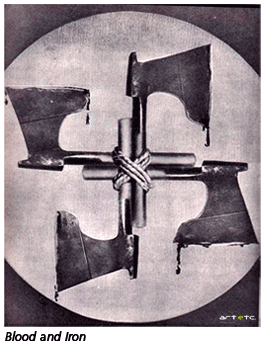
 John Heartfield through his excellent photomontage and protest ideologies tried to speak the tale of the unfortunate fate of the hungry and bleak country, while the wealthy kept no stones unturned to support the German army and Hitler and thereby went on exploiting the country on violent and greedy terms. One such photomontage that clearly brings out this essence is Adolf the Superman: Swallows Gold and Spouts Junk. The photomontage depicts Hitler, with his chest and abdomen being shown as an X-Ray impression. The belly is full of coins while a Swastika in bold is clearly visible on his chest. The hatred that the artist nurtured towards Hitler comes out clearly through each and every photomontage work he compiled. Apart from Hitler he has also worked with themes like Jesus Christ and Swastika. Two of his most important work in these themes is As in the Middle Ages…So in the Third Reich and The Cross was not Heavy Enough. Both the works depicts Jesus and brings out the terrible incident of the crucification of the Christ and thereby highlights how the common people were subjected to the terrible treatment by the Nazi regime. Yet another revolutionary work by the artist is Blood and Iron which clearly brings out the fate of the common people and describes how these people are everyday exploited under the broad umbrella of the swastika or the fascist regime. The photomontage is done by using of images of iron axes, which are arranged in the form of a huge Swastika by tying them end to end.
John Heartfield through his excellent photomontage and protest ideologies tried to speak the tale of the unfortunate fate of the hungry and bleak country, while the wealthy kept no stones unturned to support the German army and Hitler and thereby went on exploiting the country on violent and greedy terms. One such photomontage that clearly brings out this essence is Adolf the Superman: Swallows Gold and Spouts Junk. The photomontage depicts Hitler, with his chest and abdomen being shown as an X-Ray impression. The belly is full of coins while a Swastika in bold is clearly visible on his chest. The hatred that the artist nurtured towards Hitler comes out clearly through each and every photomontage work he compiled. Apart from Hitler he has also worked with themes like Jesus Christ and Swastika. Two of his most important work in these themes is As in the Middle Ages…So in the Third Reich and The Cross was not Heavy Enough. Both the works depicts Jesus and brings out the terrible incident of the crucification of the Christ and thereby highlights how the common people were subjected to the terrible treatment by the Nazi regime. Yet another revolutionary work by the artist is Blood and Iron which clearly brings out the fate of the common people and describes how these people are everyday exploited under the broad umbrella of the swastika or the fascist regime. The photomontage is done by using of images of iron axes, which are arranged in the form of a huge Swastika by tying them end to end.
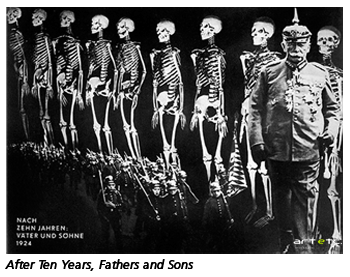 The artist clearly pours out his hatred towards the cruel fascist regime in each of his work. It was in 1924 that Heartfield came across and sealed a friendship with Berrolt Brecht and from then on the craze for photography struck him and he began using the same to shape out his protests and thus, was born his first photomontage After 10 Years-Fathers and Sons in Berlin. The montage works on the imagery of skeletons as sons while a fat old man in army uniform leads the league of skeletons forward. Each montage designed and compiled by the artist presents an extremely suffocating and totally alarming sight of the country during the aftermath of the World War I.
The artist clearly pours out his hatred towards the cruel fascist regime in each of his work. It was in 1924 that Heartfield came across and sealed a friendship with Berrolt Brecht and from then on the craze for photography struck him and he began using the same to shape out his protests and thus, was born his first photomontage After 10 Years-Fathers and Sons in Berlin. The montage works on the imagery of skeletons as sons while a fat old man in army uniform leads the league of skeletons forward. Each montage designed and compiled by the artist presents an extremely suffocating and totally alarming sight of the country during the aftermath of the World War I.
Even though Heartfield passed away on 26 April 1968, he has never stopped inspiring the world and his solo exhibitions are still in full swing in Berlin and other parts of the globe. His works titles have remained a constant inspiration for various German bands and they have composed songs around his titles. Hurrah, die Butter ist Alle! was recorded as a song by the band Blurt and the Swiss darkwave band Mittageisen (1981-1986) called themselves after this title. Laibach, a Slovenian avant-garde act has even gone as far as recording a song Herzfeld, after the artist. Apart from the inspirations the grave of John Heartfield in Berlin is a common tourist attraction and the huge 'H' embossed on the grave leaves a mark of its own. His famous A Hand has 5 Fingers was in time used on System of a Down's anonymous debut album cover.
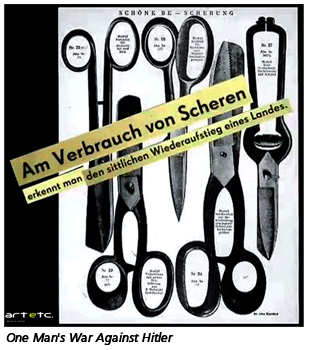
 Apart from working with general photomontages giving out political messages, the artist has used himself several times to speak the language of protest. In 1929, he created a montage of himself as a monster slicing off the head of Zörgiebel, an elderly SPD police chief of Berlin. The montage was part of a page titled Use Photography as a Weapon. His antagonistic approach towards Hitler did not only come out through his works of art but, also came out clearly through his exhibitions as well. In 1933, Heartfield fled from Berlin and moved to Czechoslovakia where in 1934, he participated in an international caricature exhibition at the Prague art society, Manes. This exhibition started giving rise to diplomatic difficulties between the Czechs and Germany. However, even though he was urged to move out of Czechoslovakia the artist was unmoved and he kept fighting his battle against Hitler and went ahead with even more exhibitions and photomontages. In 1937, when the Czechs begun facing a threat from Germany Heartfield had to remove some of his photomontages from the exhibitions he was taking part in, nevertheless the diplomatic policies were not able to demean the morals of the artist and he simply bid farewell to his family and crossed borders to reach UK. It was here that Heartfield's revolutionary ideologies and protests became all the more profound. In 1939, to make his protests more pronounced Heartfield exhibited his works at the Arcade Gallery in London and named it One Man's War Against Hitler.
Apart from working with general photomontages giving out political messages, the artist has used himself several times to speak the language of protest. In 1929, he created a montage of himself as a monster slicing off the head of Zörgiebel, an elderly SPD police chief of Berlin. The montage was part of a page titled Use Photography as a Weapon. His antagonistic approach towards Hitler did not only come out through his works of art but, also came out clearly through his exhibitions as well. In 1933, Heartfield fled from Berlin and moved to Czechoslovakia where in 1934, he participated in an international caricature exhibition at the Prague art society, Manes. This exhibition started giving rise to diplomatic difficulties between the Czechs and Germany. However, even though he was urged to move out of Czechoslovakia the artist was unmoved and he kept fighting his battle against Hitler and went ahead with even more exhibitions and photomontages. In 1937, when the Czechs begun facing a threat from Germany Heartfield had to remove some of his photomontages from the exhibitions he was taking part in, nevertheless the diplomatic policies were not able to demean the morals of the artist and he simply bid farewell to his family and crossed borders to reach UK. It was here that Heartfield's revolutionary ideologies and protests became all the more profound. In 1939, to make his protests more pronounced Heartfield exhibited his works at the Arcade Gallery in London and named it One Man's War Against Hitler.
The idea of photomontage and making use of the same to pull out his protests was born only after 1924. However, the great artist John Heartfield was always disturbed by the techniques practiced by the Nazi regime under the rule of Hitler (The Great Dictator). The artist merely found a way to express his problems and thereby point his fingers towards the adversities only after he learned to work it out with photomontages. Standing here at present it is easily identifiable that the artist had indeed raised his voice for mankind and has been able to speak out loud and has simply left his impressions on the shores of humanity and opened a new way for the generations to come to channel out protests and speak out against the system whenever, cruelty and barbarism is practiced in the society.